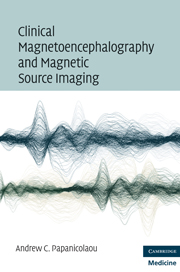Book contents
- Frontmatter
- Contents
- Contributors
- Preface
- Section 1 The method
- Section 2 Spontaneous brain activity
- 11 MEG recordings of spontaneous brain activity – general considerations
- 12 Normal spontaneous MEG – frequently encountered artifacts
- 13 Spontaneous MEG morphology
- 14 Abnormal spontaneous MEG
- 15 Contributions of MEG to the surgical management of epilepsy – general considerations
- 16 MEG investigations in lesional epilepsies
- 17 MEG investigations in nonlesional epilepsies
- 18 Pediatric nonlesional epilepsy surgery
- Section 3 Evoked magnetic fields
- Postscript: Future applications of clinical MEG
- References
- Index
17 - MEG investigations in nonlesional epilepsies
from Section 2 - Spontaneous brain activity
Published online by Cambridge University Press: 01 March 2010
- Frontmatter
- Contents
- Contributors
- Preface
- Section 1 The method
- Section 2 Spontaneous brain activity
- 11 MEG recordings of spontaneous brain activity – general considerations
- 12 Normal spontaneous MEG – frequently encountered artifacts
- 13 Spontaneous MEG morphology
- 14 Abnormal spontaneous MEG
- 15 Contributions of MEG to the surgical management of epilepsy – general considerations
- 16 MEG investigations in lesional epilepsies
- 17 MEG investigations in nonlesional epilepsies
- 18 Pediatric nonlesional epilepsy surgery
- Section 3 Evoked magnetic fields
- Postscript: Future applications of clinical MEG
- References
- Index
Summary
Nonlesional temporal lobe epilepsies (TLEs)
MEG is used to noninvasively differentiate between mesial and lateral neocortical epileptic regions in cases with nonlesional TLEs. In addition to dipole localizations, dipole orientations are being studied for diagnostic information. Anterior temporal vertical dipoles, according to Pataraia and coworkers, consistently localized to the mesial basal temporal compartments in the ipsilateral temporal lobe, whereas anterior horizontal dipoles localized more to the temporal pole and adjacent part of the lateral temporal lobe compartments and, in 50%, showed bitemporal spikes or seizure onsets. Surgical outcome after selective amygdala hippocampectomy was slightly better in patients with anterior temporal vertical dipoles. In other findings, anterior medial vertical dipoles were associated with mesial seizure onsets, while posterior lateral vertical dipoles occurred in patients with lateral or diffused seizure onsets. Comparisons of dipole orientations from data of different recordings will strongly depend on the choice of dipole source and volume conductor model. Simulations comparing different volume conductor models (spherical, 1- and 3-shell realistic BEM) demonstrated that differences of up to 90 degrees for the same spike patterns and analysis interval can occur, depending on tangentiality of the simulated source. Only the 3-shell realistic BEM was found to generate errors of less than 20 degrees with respect to the predefined simulated dipole orientation. Results that differ from other findings might, therefore, be caused by differences in the analysis procedure rather than by actual (patho)physiology.
- Type
- Chapter
- Information
- Publisher: Cambridge University PressPrint publication year: 2009



